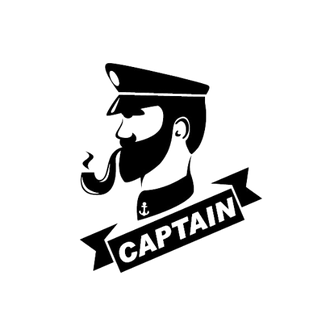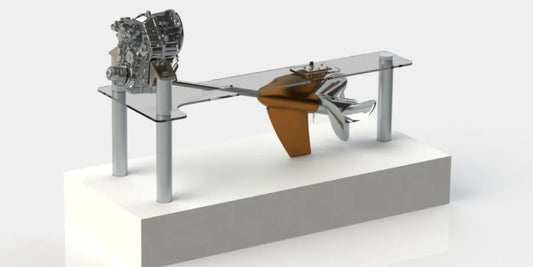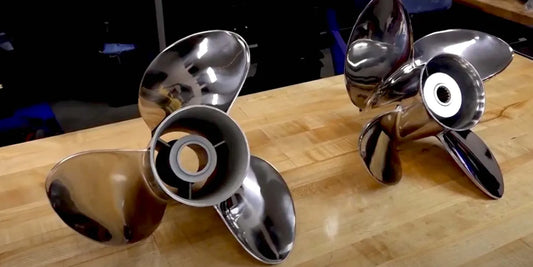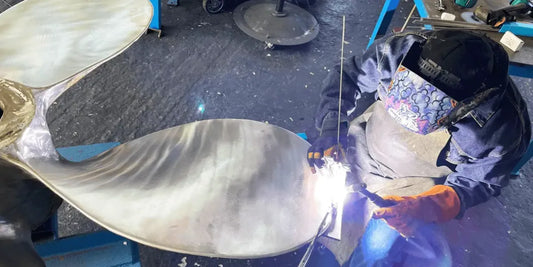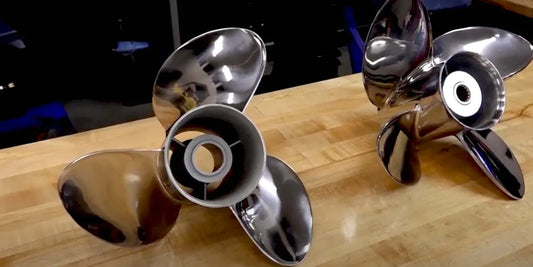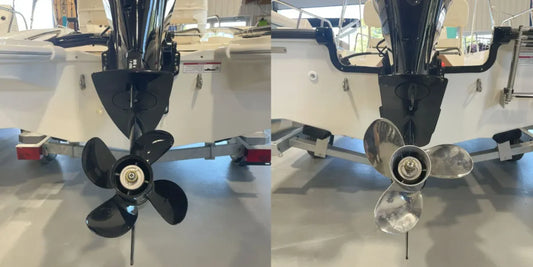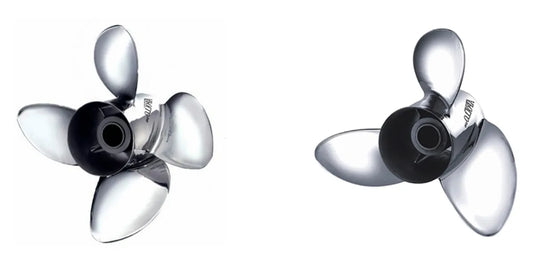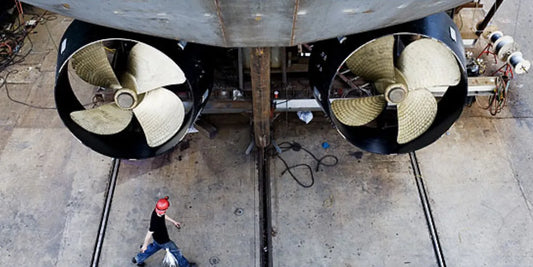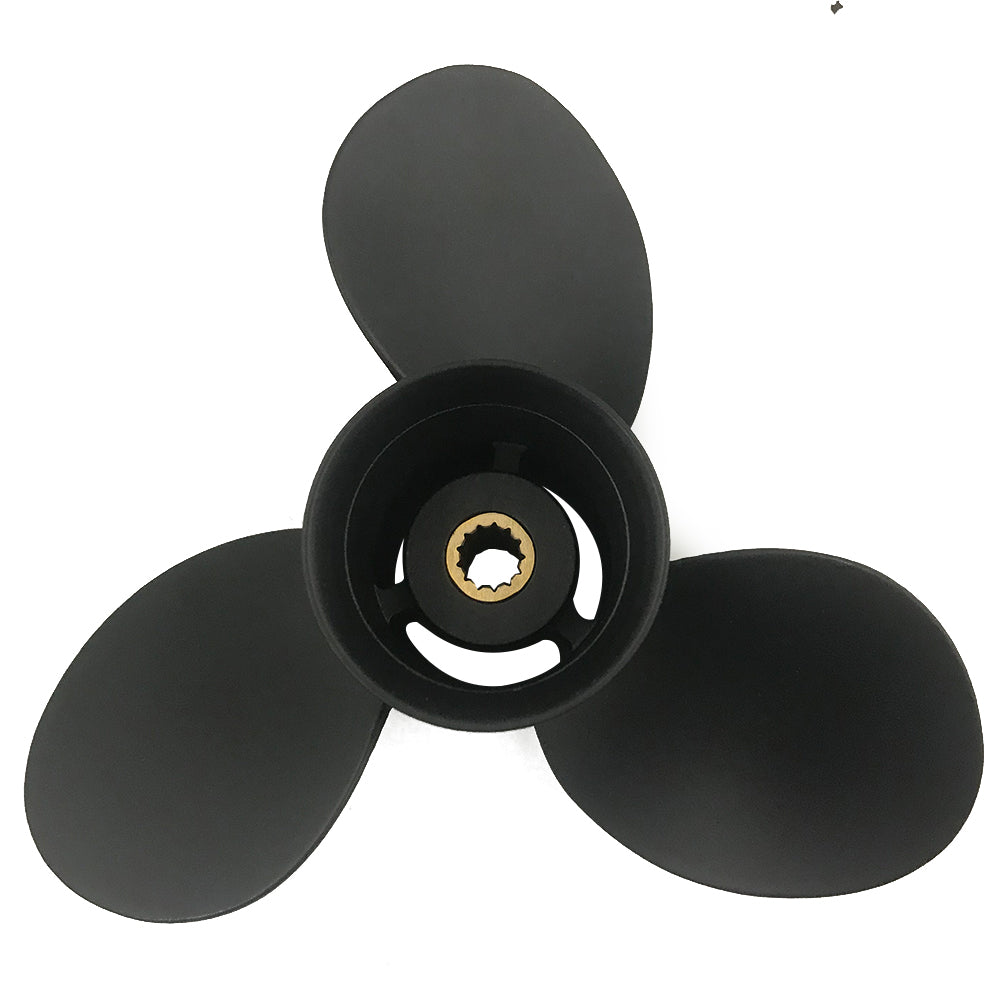Choosing the correct propeller can make all the difference in enhancing the speed of your boat. One of the major talks among boating enthusiasts, anglers, and water sports enthusiasts is the 3-blade versus 4-blade propeller issue. Each has its own pluses and minuses that affect speed, turning, fuel consumption, and general handling. This article gets to the heart of the matter by comparing each propeller's performance traits, putting you in a position to make an informed decision. Whether your intention is high speed or stability, here are some pointers to help you select the suitable propeller for your boating adventure.
Introduction to Propeller Types

Understanding 3-blade Propellers
3-blade propellers are the common choice for almost every type of watercraft because of their balanced performance characteristics. They offer speed, efficiency, and stability to satisfy casual boaters and their more performance-oriented counterparts. Three-blade propellers are generally made for boats where speed usually takes precedence, as less drag permits forward propulsion at higher rpm than a 4-blade propeller.
The fantastic offer with 3-blade propellers is the excellent acceleration response time and maximum speed possible, among lighter vessels, where it could be paramount to achieve agility and quick maneuvering. While in the open waters, 3-blade propellers perform well since maintaining pace over long distances is the priority. Performance trials and expert analyses have often favored 3-blade propellers as more power-efficient, as their reduced blade area means less hydrodynamic resistance.
On the downside, fewer blades may lead to a slight compromise in grip and low-speed thrust compared with 4-blade options. This trade-off will be most keenly felt in choppy waters or precise handling situations —tight docking being a prime example. Awareness of such undercurrents could better inform operational priorities when selecting the pro pouches elite for their application.
Understanding 4-blade Propellers
4-blade propellers are meant to optimize the balance of performance and control, especially in more demanding situations. More blades mean more surface area to grip the water and get better handling precision. This solution fares best in situations requiring more stability, such as rough seas and tight docking maneuvers. It's also worth mentioning that 4-blade props offer a more efficient and smoother act of thrust than others, with the least amount of vibration drifting onto the boat.
Studies indicate that these propellers are preferred to keep speed in sharp turns and turbulent conditions. On the other hand, they may get a tiny bit goldered in top-end speed by 3-blade models, drag being upped with an added blade. However, a 4-blade would best suit a boat wanting to be versatile under fuel-efficient and high-performance conditions. Furthermore, these propellers are said to save fuel and prolong engine life due to an enhanced grip that possibly allows the engine to operate at its most-conducive range. This understanding of 4-blade propellers' benefits and trade-offs ensures boaters find the right fit for their operational needs.
Key Differences Between Blade Types
When distinguishing between 3-blade and 4-blade propellers, the difference lies in their performance, efficiency, and functions under various conditions. The 3-blade propeller will generally perform better in attaining higher top-end speeds and quicker acceleration due to much less drag. It is much more of a desired stripper among boats prioritizing speed and agility; racing or high-performance boats are among this class. Because the 3-blade propeller weighs less, it is also stronger in these aspects of efficiency, giving quicker response to throttle adjustment by the boat operator.
The 4-blade propellers are better at maximizing thrust, allowing performance to remain steady in rough-water conditions. The other blade means it can get a much better grip and cut down cavitations, making for much smoother operation and handling in low-speed situations. When requiring precision, such as trolling or working in tight confines, a 4-blade configuration wins out. With enhanced balance, the 4-blade propeller cuts down vibrations, providing boaters a quieter and more pleasant experience.
When comparing the two, consider the following: what type of boat do you have, how are you intending to use it, and what performance results are you looking to get? By picking the right blade, boaters will get the best fuel efficiency, performance, and satisfaction from Cape to Seal.
Performance Analysis of 3-Blade vs 4-Blade Propellers

Speed and Efficiency of 3-Blade Propellers
Most boaters will select three-blade propellers for their top acceleration capability. A three-blade propeller tends to slice through the water more easily due to its fewer blades, allowing the engine to turn at its maximum RPM. Hence, applications wherein speed is a requisite, such as racing boats, lightweight craft, or vessels designed for fast transport, are particularly apt to suit the 3-blade configurations. Throw in the instant acceleration that traverses the smooth waters, and you now have icing on the cake with 3-blades that allow your boat to get quickly up on plane.
3-blade propellers are another efficient solution for the conservation of fuel. By balancing thrust and resistance, the thrust generated by a 3-bladed propeller assures that the vessel can cruise faster and smoother with far more complex compromises on fuel expenditures over the long distances; something desired by fishermen and motorboaters who value fuel-cost considerations on long excursions. While some trade-offs down low or in rough conditions concerning torque and stability may occur, the combined aspects of speed and fuel economy lend to the versatility of 3-blade propellers.
Speed and Efficiency of 4-Blade Propellers
Flying under the radar for many blade designs, the choice of the four-blade propellers depends on what power is necessary for control, increased thrust, and endurance away from high-speed maneuvers. These propellers offer high thrust and superior handling at slow speeds and in rough conditions. Increased surface area from the extra blade makes propulsion and stability more consistent, meaning that four-blade propellers are ideal for those boats used to tow water skiing or wakeboarding activities and vessels navigating choppy and turbulent waters, where control is of the utmost concern.
Four-blade propellers may not be able to reach higher speeds than those with fewer blades, but they do excel in acceleration and midrange performance. This ability is advantageous, providing a smooth and rapid planning process, an essential ingredient for boats carrying heavy payloads or many passengers. In addition, increased blade surface helps reduce cavitation, which makes it more efficient and comfortable in the long run. The trade-offs for speed are often worth it, particularly for any boater who finds themselves valuing stability and fuel economy in challenging conditions.
Performance evaluation shows that a four-blade propeller is better due to its fuel economy at cruising travel speeds. For many fishermen, divers, or recreational boaters traveling at cruising speeds, there are good potential savings brought about by this efficiency in the long term. Also, these propeller designs reduce vibration, which reduces noise levels- a much-appreciated feature for passengers of any vessel! In general, the design and performance characteristics have positioned four-blade propellers to be versatile and dependable for varying boating needs.
Comparative Performance Metrics
Speed, fuel efficiency, and handling are essential when considering and comparing propeller performance. Four-blade propellers tend to provide greater thrust at lower speeds, hence being appropriate for water sports activities and cruising. In contrast, three-blade propellers generally tend to achieve a higher top speed due to less drag interference due to having less blade surface.
Fuel consumption, an important concern to boaters, tends to vary according to application and engine pairing. The four-blade design tends to optimize fuel efficiency at mid-range, while the three-blade design may perform better at full throttle. Handling distinguishes the two; with an additional blade, a four-blade propeller renders smoother and more stable operation, especially in rough water or during tight maneuvers.
Depending upon the intended use and vessel characteristics, developing meaningful strategies around these metrics provides solutions that guarantee excellent performance outcomes.
Handling and Maneuverability

3-Blade Propeller Handling Characteristics
The handling characteristics of the 3-blade propeller lend themselves to vessels that seek greater speeds and agility. The less-dragged design allows it to glide smoothly and swiftly into the water. One of its principal advantages lies in its ability to shorten the time it takes for an object to attain maximum speed, thanks to its comparatively lighter weight and lesser rotational inertia, since quick maneuvers and fast answers tend to be of utmost concern.
Though at navigation, when it comes to stability, 3-blade propellers keep their performance predictable, making them trustworthy for motorboats or in situations where a measure of agility is prioritized over striving for a massive output power. Fuel efficiency is another advantage, owing to lesser resistance, which means smoother propulsion under the lower load of engines. However, the best maneuvering potential in calm and moderate water conditions may pose slight difficulties to 3-blade propellers while affording stability in the rougher seas for 4-blade.
It is worth considering that vessel type, weight distribution, and boat use should be contemplated when discussing compatibility, so that the 3-blade propeller would be an equally good option for maneuverability and efficiency.
4-Blade Propeller Handling Characteristics
Handling stability is one major factor for 4-blade propellers, especially in harsher and difficult water conditions. With an additional blade compared to the 3-blade propellers, thrust and torque are enhanced, ensuring that these propellers are excellent for larger and heavier vessels or boats frequently carrying heavy engines and loads. This also makes acceleration smoother and increases water grip, preventing slippage and maintaining performance in harsh turns or stressful manoeuvres.
So, are four blades ideal for small engines where better low-speed planing can be achieved? It's great for fishing or towing, and they are believed to be more fuel efficient at cruising speed due to lesser cavitation and balanced force distribution. However, this still could limit top-end speed relative to that of 3 blades, which is a hundred percent better anyway for applications that value control and dependability over speed. Thus, when appropriately matched to the design and operation of a powerboat, boaters stand to improve their performance and navigate confidently through all of the varying conditions.
Which Prop Offers Better Maneuverability?
Propeller designs have a high degree of variation when determining the maneuverability factor, such as differences in blade number, surface area, and design dynamics. The 4-blade propellers are generally accepted as superior in maneuverability; increased surface area entails a better grip in the water. The increase in grip directly impacts low-speed acceleration and gives additional directional control to maneuvers that are perfect for docking or negotiating tight channels.
Contrasting this are 3-blade propellers having reduced drag, favoring velocity and efficiency, yet may be slightly subdued with precision in control, primarily in the more technical maneuvers. The determination between the two types varies depending on their application, with the 4-blade adopted for heavier loads or vessels having a strenuous operation in complex routes. At the same time, the 3-blade is used for situations where speed and fuel efficiency take precedence. By understanding these differentiations for your requirements, you will benefit significantly in deciding which appliance would better help the maneuverability and performance of your vessel.
Cost Considerations

Price Differences Between 3-Blade and 4-Blade Props
The prices of 3—and 4-blade props vary considerably depending on the material used, the manufacturer's branding, the prop's size, or even its performance features. Generally, 3-blade props are cheaper because of their simple design and lighter use of materials. Usually available in vast options, 3-blade propellers have become the favorite of kind holders who utilize their speed and fuel efficiencies for recreational applications.
The price is higher for 4-blade props because of increased application and use of materials. With thrust as a priority, the design of 4-blade props ensures good performance under heavy loads, even in choppy seas, and the handling proficiency price would be justified by greater performance. Operators may lean toward these arrangements wherever enhanced maneuverability and guaranteed performance in heavy conditions are required.
Buyers must evaluate their requirements and operational conditions when considering 3-blade or 4-blade designs with respect to cost and performance benefits. Materials like aluminium or stainless steel could be considered in different cost dimensions. Stainless steel, usually associated with increased durability and better performance, is very expensive.
Cost vs Performance Trade-offs
When performing a cost-performance analysis for propellers, decision-makers should look at the initial investment and the value they provide in the long term. For example, aluminum propellers are highly regarded for their great prices and lightness and are hence commonly selected by small-time or recreational boaters. However, they have their downside in that they are not too durable and will almost always need replacing after hard use or in abrasive conditions.
On the other hand, they are propellers of much greater cost initially, but bring value from their long working life and increased performance. They are exceptionally preferred for their impregnability and ability to operate well at high speed, which suggests that stainless steel further reduces the operating cost, in terms of fewer replacements and better fuel usage, as time goes on.
Trends provide insight into developments in the performance of materials, for example, showing how stainless steel props are favoured in the professional and performance boating arena, enabling buyers to make more informed decisions. Further, high-tech blade geometries blur cost trails with performance, too, as some of these costly aluminum options are now bordering on the efficiency criteria of traditional stainless steel ones.
Long-Term Value and Durability
When long-range value and durability go hand in hand, stainless steel propellers are often cast as villains in the arena of resilience and performance over time, where they provide for substances. Ramifications of harsh marine environments give criminal records, compared to great marine records. These propellers resist corrosion, abrasion, and even impact damage. This makes them a good pick for the marine operator with all terrains across freshwater and saltwater. Compared to aluminum, stainless steel ensures fewer replacements, thus reducing operational costs over long periods. Stain steel's rigidity greatly increases the possibilities for more precise and even thinner blade designs, which simultaneously allows for better efficiency and consistent performance under adverse conditions.
In the meantime, high-tech aluminum has been advancing in terms of the durability and value of aluminum propellers. Exotic aluminum now includes coating and treatments which improve corrosion and abrasion resistance, almost ending the durability disadvantage with stainless steel. This introduces a high-tech aluminum opportunity to the boater at a much lower price, yet without compromising performance. Yet, while aluminum may wear faster under extreme stresses, it's still a practical option for casual boating, making the perfect backup when available at a low upfront cost.
Ultimately, the decision between stainless steel and advanced aluminum is often weighted towards the initial costs versus the long-term gains. For high-performance or professional applications where precision and durability are critical, stainless steel may be the best choice in the long run. Aluminum is probably the best compromise for those who boat for recreational activities or are on a tighter budget. Both materials show how propeller manufacture is growing and how innovation is sketched onto the cost-efficiency and value for the buyer in the boating industry.
Choosing the Right Propeller for Your Boat

Factors to Consider When Selecting Prop Type
When selecting a propeller suitable for my boat, I always begin with considerations of size and pitch. These two will directly impact performance in determining how much of the force generated is efficiently converted to resistance for moving through water and, therefore, adequately suit what I intend to do with my boat, watersports, fishing, or cruising. I must always check to confirm that the propeller size matches the ship and engine specifications because if it does not, it might lead to fewer speeds being achieved, poor fuel economy, or, worse, just strain the engine.
The next very important factor I consider is the propeller's material. Stainless steel propellers are generally known to be more durable and perform better in high-speed or heavy-duty applications. However, aluminum propellers are a cheap alternative and light, making them suitable for more casual use. My choice depends on performance needs balanced against my budget, avoiding low value or overspending.
Finally, I check the number of blades on the propeller. For example, three-blade propellers are suitable for high top-end speed, whereas four- and five-blade propellers offer better acceleration, handling, and smoothness in rough water. Acting my way through the above factors helps me wipe clean that choice of prop type for a better boating experience and better performance of my vessel.
Matching Prop to Boat Specifications
While matching the propeller with the boat specifications, the size and weight of my vessel are always the first things that come to my mind. Larger, heavier boats generally require propellers of larger diameters to generate enough thrust to maintain performance. In contrast, smaller, lighter boats perform better with smaller diameter ones optimized for speed and efficiency. Knowing the weight and engine power of the ship becomes important because an optimal combination ensures that I do not overwork the engine with either too much prop or too little for an agreeable performance from my end.
The propeller's pitch is another thing I think about with great care because it directly affects the engine RPM and its overall performance. Low pitch props help with power and acceleration and, as a result, are perfect for towing or heavy loads. In contrast, high-pitched props are ideal for speed and fuel savings on boats used for much lighter loads or cruising around. I have always paid attention to my engine's RPM range, for utilizing a pitch wrong could either put too much strain on the motor or fail to put it to its best.
Lastly, I have to decide on how to build my props. Aluminum props provide an adequate balance between price and durability for light recreational use. Stainless steel props perform better by reducing drag and can withstand harsher conditions and applications. When considering these factors about my boat specifications, I choose a propeller consistent with how I want to use it, allowing the techniques to maximize their abilities and keeping the engine and propeller in harmony.
Expert Recommendations on Blade Selection
The choice of the number of blades and their working ability is essential for me in picking propellers, as per the demands of my work in boating. A three-blade propeller often provides the best balance between speed and efficiency for general recreational uses. The drag is minimized with this design to give a smooth ride, thus making it suitable for watersports or cruising. However, I will go with a four-blade propeller where more thrust is required, for example, in towing or moving heavy loads. This set-up gives more power at lower speeds and greater stability in heavy seas.
Blade materials are yet another crucial factor. Aluminum blades are more versatile, less expensive, and well-suited for light-to-moderate workloads, whereas stainless steel blades are stronger and more durable. This equipment makes it an excellent choice for high-performance activities or challenging environments. Additionally, I pay close attention to blade pitch and diameter. The higher pitch means greater top-end speed but sacrifices acceleration. The lower pitch maximizes acceleration and is better suited for towing or water sports. By looking at all these things from different angles, I pick a blade that best fits my boating work, where reliability is etched in stone, and fuel efficiency is guaranteed.
Reference Sources
- 3-Blade vs. 4-Blade Propeller - Michigan Wheel
- 3 or 4 Blade Prop: Which is Better for Planing Faster? - Reddit
- 3-Blade Propeller vs 4-Blade Propeller - Boat Design Forum
- Over Propped? 18x4 3 Blade vs 18x13 4 Blade - Boat Design Forum
Frequently Asked Questions (FAQs)
What are the advantages of a 3-blade prop over a four-blade prop?
A 3-blade prop is designed for top speed and high rpm operation. This is due to the lower blade area acting against drag. Such a prop is typical of the boats designed for high speed, where speed is given priority over pulling power. A 3-blade prop might not perform as well as four blades at slower speeds during hole shots. Fewer blades generally translate to quicker acceleration, but at some compromise with fuel economy. Thus, depending on a boat's hull type and intended use, the power plant may be three- or four-bladed.
How does a four-blade prop perform when slow?
A 4-blade prop performs better at slower speeds, giving a better hole shot and greater thrust than a 3-blade prop. This is because more surface area, provided by the extra blade, helps the boat to get on plane quicker. For recreation boats that have to operate in fairly rough water or need to accelerate quickly, the 4-blade design works well, especially if a little bit of low-top-end speed sacrifice is acceptable. Boaters tend to like the extra pull that the 4-blade prop will offer under various conditions, making it rather versatile.
Does a better fuel economy exist for a 3-blade or a 4-blade prop?
Regarding fuel economy, a 3-blade prop tends to yield better mileage at high speeds because of lesser drag. On the other hand, at lower rpm, especially during cruising or heavy load pulling, a 4-blade prop might improve fuel economy. Ultimately, it depends on the boat type: what people want more, the 4-blade for top speed or the 3-blade for low speed? It would be wise to strike a balance between throttle response and fuel consumption; experimenting with different props could be rewarding for your fuel economy.
Can a 3-blade prop improve the experience on rough water?
A 4-blade prop is generally more popular in rough water conditions for a more stable and comfortable ride. It gives the extra blade to grip better and control. A 3-blade could work well, depending on hull design and weight distribution. While a 3-blade prop might allow quicker maneuvers, it might not cope well in rough conditions as a 4-blade prop. The decision will ultimately depend on things like boat weight and intended use. Going for a 4-blade prop will likely prove a rewarding investment for those frequently cutting through choppy waters.
How do you choose the right prop for your boat?
In order to find out what will be the best for your boat, there's enough room to wander over the broad spectrum of considerations: hull design, intended use, and engine specs. The count of blades defines the most important part: is it a 3-blade or a 4-blade? A 3-blade prop may give you the top speed, whereas a 4-blade prop gives you low speed and fuel efficiency. Furthermore, you want a pitch and diameter that will match your outboard. A boat forum will be another good source of tips from boaters who may have worn down a few props with you as they went along. Неre at the end of the day, you may have to try out a few right and wrong setups to find something that balances something right for your needs and kind of boating.
What effect does diameter have in terms of performance?
The diameter of your prop will significantly change the performance from acceleration to top speed. Bigger diameter props provide more thrust and are thus better used when your boat is heavy or you're pulling loads. But they might lower your rpm count, and hence your top-end speed, if not correctly matched to your engine. While small-diameter props tend to boost your rpms and top speed, their hole shots may be lacking, as will their low-speed maneuvering. Considering your particular need for your boat in its usual operational conditions is a crucial selection criterion for the diameter of your prop.
